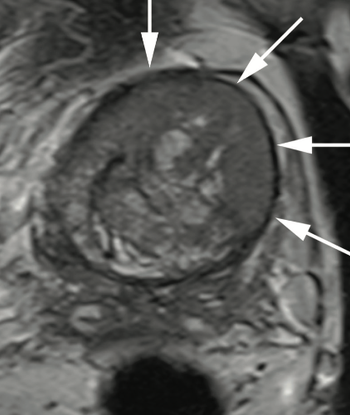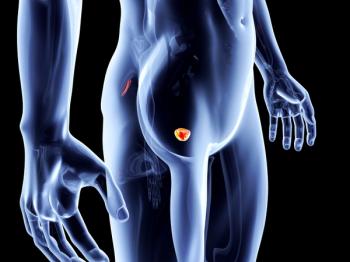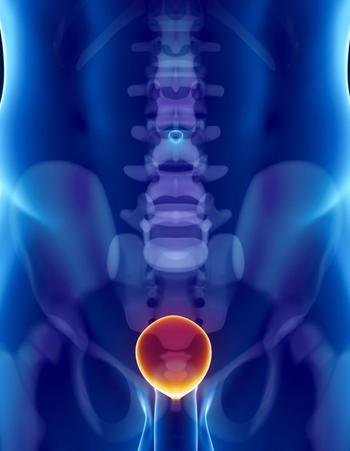
Prostate Cancer
Latest News
Latest Videos

More News

A prostate cancer expert shares rationale for his preferences and choices while sequencing therapies in prostate cancer.

At a recent conference, Robert Dreicer, MD, MS, MACP, FASCO, offered his advice regarding the use of androgen deprivation therapy in patients with metastatic castration-sensitive prostate cancer.

Dr Liaw discusses ways to measure response to treatment and what recent data regarding PSA kinetics has shown.

Dr Bobby Liaw talks about relationship between treatment duration, dosing and efficacy.

Dr. Judd W. Moul, MD, and colleagues present the case of a man, aged 73 years, with a prostate-specific antigen level of 110 ng/mL after 4 negative prostate biopsies and 4 negative prostate MRIs.

Axel Merseburger, MD, PhD, looked back on 2022 ASCO GU and the new data presented for the treatment of prostate cancer.

In this program Atish D. Choudhury, MD, PhD, discusses recent updates on long-term safety and efficacy data in patients with metastatic castration-sensitive prostate cancer and the importance of patient communication and quality of life while on treatment.

Dr. Atish Choudhury discusses safety features to keep in mind when choosing androgen receptor pathway inhibitors.

A prostate cancer expert shares long-term data with androgen receptor pathway inhibitors in mCSPC.

Dr. Liaw shares the role disease burden and other factors play in treatment selection.

Dr. Choudhury discusses treatment considerations and treatment options for mCSPC.

Applications for darolutamide were submitted to the FDA and European Medicines Agency for the treatment of patients with non-metastatic hormone-sensitive prostate cancer.

The addition of prostate radiation therapy to androgen deprivation therapy appears to be cost effective in patients with low-volume metastatic hormone-sensitive prostate cancer.

Eleni Efstathiou, MD, PhD, spoke about how results of the phase 3 MAGNITUDE trial, which examined the combination of niraparib with abiraterone acetate and prednisone, have the ability to change the standard of care in patients with metastatic castration-resistant prostate cancer.

Matthew Allaway, DO, detailed benefits of using an emerging transperineal biopsy approach to identify prostate cancer in hard to access areas of a patient’s prostate.

Eleni Efstathiou, MD, PhD, spoke about the positive results seen in the phase 3 MAGNITUDE trial in patients with metastatic castration-resistant prostate cancer harboring homologous recombination repair gene alterations who were treated with a niraparib-containing regimen.

A health-related quality of life assessment found an association between worsened self-reported fatigue, cognitive function, and physical function, with enzalutamide treatment for patients with metastatic, hormone-sensitive prostate cancer but improved deterioration-free survival for overall health and quality of life.

Axel Merseburger, MD, PhD, spoke key results of the PRESIDE trial, which examined continuous enzalutamide to treat patients with metastatic castration-resistant prostate cancer and progressive disease.
![A statistically significant benefit in terms of radiographic progression-free survival (rPFS) was noted with the use of olaparib (Lynparza) vs placebo in combination with abiraterone acetate (Zytiga) for patients with frontline metastatic castration-resistant prostate cancer (mCRPC), according to results of the phase 3 PROpel trial (NCT03732820) that were presented at the 2022 Genitourinary Cancers Symposium.1 The median investigator-assessed rPFS was 24.8 months with olaparib/abiraterone vs 16.6 months with placebo/abiraterone (HR, 0.66; 95% CI, 0.54-0.81; P <.0001), which translated to a 34% reduction in the risk of radiographic disease progression or death. The 1- and 2-year rPFS rates were 71.8% and 51.4% in the olaparib/abiraterone arm, respectively; these rates were 63.4% and 33.6% with placebo/abiraterone, respectively. When evaluated by blinded independent central review, the median rPFS with olaparib/abiraterone was 27.6 months vs 16.4 months with placebo/abiraterone, leading to a 39% reduction in the risk of radiographic disease progression or death (HR, 0.61; 95% CI, 0.49-0.74; P <.0001). The 1- and 2-year rPFS rates with olaparib plus abiraterone were 73.8% and 53.7%, respectively. In the placebo/abiraterone arm, these rates were 60.6% and 34.1%, respectively. Lead study author Fred Saad, MD, FRCS, said that PROpel is the first combination approach to deliver consistent clinical benefits for patients in the first-line mCRPC setting, irrespective of homologous recombination repair (HRR) mutation status. “This benefit led to what I think is the longest rPFS we have seen to date in metastatic CRPC beyond 2 years,” Saad, who is professor and chairman of urology and director of Genitourinary Oncology at the University of Montreal Hospital Center, as well as the Raymond Garneau Chair in Prostate Cancer Research and director of Clinical Research and the Molecular Oncology Research Laboratory in Prostate Cancer, said in a presentation during the meeting. Patients with mCRPC who are treated in the frontline setting have a median survival of approximately 3 years in clinical trial settings, Saad noted, adding that about half of patients in real-world practice only receive 1 line of active treatment. Here, the median survival is less than 2 years, underscoring an unmet need to improve outcomes in the up-front setting. Previously, data with olaparib in mCRPC have shown encouraging results. The phase 3 PROfound trial (NCT02987543) demonstrated significantly prolonged rPFS and overall survival (OS) in patients with mCRPC following a next-generation hormonal agent (NHA) with HRR gene alterations.2 Additionally, a phase 2 trial (NCT01972217) of olaparib and abiraterone showed prolonged investigator-assessed rPFS vs placebo/abiraterone in patients with mCRPC following treatment with docetaxel, regardless of HRR status (HR, 0.65; 95% CI, 0.44-0.97; P = .034).3 In the international, double-blind, phase 3 PROpel trial, investigators randomized patients with mCRPC in the first-line setting 1:1 to receive olaparib at 300 mg twice daily plus abiraterone at 1000 mg daily (n = 399) or placebo and abiraterone at 1000 mg daily (n = 397). Patients could have received docetaxel in the metastatic hormone-sensitive prostate cancer (mHSPC) setting, but no prior abiraterone was allowed. Other NHAs were permitted if they were stopped at least 12 months prior to study enrollment. Patients also had ongoing androgen deprivation therapy and an ECOG performance status of 0 or 1. Stratification factors included site of distant metastases (bone-only vs visceral vs other) and prior taxane in the mHSPC setting (yes vs no). The primary end point was investigator-assessed rPFS, with OS as a secondary end point. Additional outcome measures included time to first subsequent therapy or death (TFST), time to second progression or death (PFS2), objective response rate (ORR), HRR mutation prevalence (retrospective testing), health-related quality of life, and safety and tolerability. Baseline characteristics were well-balanced between the 2 arms. The median age was 69.5 years (range, 43-91), and most patients had an ECOG performance status of 0 (70.1%). Of note, symptomatic patients (Brief Pain Inventory-Short Form ≥4 and/or opiate use) comprised 25.8% and 20.2% of olaparib- and placebo-treated patients, respectively; 22.5% of patients had received docetaxel at the mHSPC stage. Additionally, patients either had HRR mutations (27.8% with olaparib vs 29.0% with placebo), non-HRR mutations (69.9% vs 68.8%, respectively), or unknown HRR mutation status (2.3% each). The median PSA was 17.90 ug/L (interquartile range [IQR], 6.09-67.00) with olaparib/abiraterone and 16.81 ug/L (IQR, 6.26-53.30) with placebo/abiraterone. Most metastases occurred in the bone at 87.5% and 85.4% of patients, respectively. Additional findings showed that the rPFS benefit was observed across all prespecified subgroups, including age (<65 years, HR, 0.51; 95% CI, 0.35-0.75; ≥65 years, HR, 0.78; 95% CI, 0.62-0.98), site of distant metastases (bone-only, HR, 0.73; 95% CI, 0.54-0.98; visceral, HR, 0.62; 95% CI, 0.39-0.99; other, HR, 0.62; 95% CI, 0.44-0.85) prior docetaxel (yes, HR, 0.61; 95% CI, 0.40-0.92; no, HR, 0.71; 95% CI, 0.56-0.89) and HRR mutation status (HRR mutant, HR, 0.50; 95% CI, 0.34-0.73; non–HRR mutant, HR, 0.76; 95% CI, 0.60-0.97). “We did do a global interaction test, which was not significant,” Saad added. OS data, which were at 28.6% maturity, showed that the median OS was not reached in either arm but trended toward improved survival with olaparib/abiraterone vs placebo/abiraterone (HR, 0.86; 95% CI, 0.66-1.12; prespecified 2-sided alpha P = .29). TFST also was favored with the addition of olaparib. The median TFST was 25.0 months in the olaparib/abiraterone arm compared with 19.9 months with placebo/abiraterone (HR, 0.74; 95% CI, 0.61-0.90; P = .004). Furthermore, the median PFS2 was not reached in either arm, but supported longer-term benefit with olaparib/abiraterone (HR, 0.69; 95% CI, 0.51-0.94; P = .0184). When evaluated for response, the ORR with olaparib plus abiraterone was 58.4% with a 4.3% complete response (CR) rate and a 54.0% partial response (PR) rate. The stable disease (SD) rate was 26.1% and the progressive disease (PD) rate was 13.7%. In the placebo/abiraterone arm, the ORR was 48.1%, which comprised a 6.3% CR rate and a 41.9% PR rate; the SD and PD rates were 28.1% and 19.4%, respectively. The odds ratio in ORR between olaparib/abiraterone and placebo/abiraterone was 1.60 (95% CI, 1.02-2.53; P = .0409). Saad noted that 40.3% of the overall study population had measurable disease via RECIST v1.1 criteria at baseline. Regarding safety, adverse effects (AEs) occurred in 97.2% and 94.9% of olaparib/abiraterone- and placebo/abiraterone-treated patients, respectively; grade 3 or higher AEs occurred in 47.2% and 38.4% of patients, respectively. AE-related deaths occurred in 4.0% (n = 16) of those on the olaparib arm compared with 4.3% (n = 17) of patients on the placebo arm. Dose interruptions and reductions occurred in 44.7% and 20.1% of patients who received the addition of olaparib; these rates were 25.3% and 5.6% for those on the placebo arm. Additionally, more patients discontinued olaparib due to an AE (13.8%) compared with 7.8% of patients receiving placebo. A total of 8.5% and 8.8% of patients in each arm, respectively, discontinued abiraterone due to an AE. There were no cases reported of myelodysplastic syndrome or acute myeloid leukemia, and the incidence of new primary cancers and pneumonitis were balanced between the 2 arms, Saad said. The AE profiles were consistent with the known toxicity profiles of the individual agents. The most common all-grade and grade 3 or higher AE with olaparib was anemia (46.0% and 15.1%, respectively). In the placebo arm, this occurred in 16.4% and 3.3% of patients, respectively. Cardiac failure occurred at similar rates between the 2 arms at 1.5% with olaparib and 1.3% with placebo; arterial thromboembolic events were also similar at 2.0% and 2.5%, respectively. However, numerically higher venous thromboembolic events were reported for olaparib/abiraterone (7.3%) vs placebo/abiraterone (3.3%), with pulmonary embolism being the most reported venous thromboembolic event (6.5% vs 1.8%, respectively). Pulmonary embolism events were mostly incidental findings via CT scans, and Saad added that this did not lead to treatment discontinuation with either olaparib or abiraterone. Quality of life was also found to be comparable between the 2 groups. References Saad F, Armstrong AJ, Thiery-Vuillemin A, et al. PROpel: phase III trial of olaparib (ola) and abiraterone (abi) versus placebo (pbo) and abi as first-line (1L) therapy for patients (pts) with metastatic castration-resistant prostate cancer (mCRPC). J Clin Oncol. 2022;40(suppl 6):11. doi:10.1200/JCO.2022.40.6_suppl.011 Hussain M, Mateo J, Fizazi K, et al. Survival with olaparib in metastatic castration-resistant prostate cancer. N Eng J Med. 2020;383(24):2345-2357. doi:10.1056/NEJMoa2022485 Clarke N, Wiechno P, Alekseev B, et al. Olaparib combined with abiraterone in patients with metastatic castration-resistant prostate cancer: a randomised, double-blind, placebo-controlled, phase 2 trial. Lancet Oncol. 2018;19(7):975-986. doi:10.1016/S1470-2045(18)30365-6](https://cdn.sanity.io/images/0vv8moc6/cancernetwork/d97c82ab46f3114f8f67bcbafa061ef7adad240a-1200x900.jpg?w=350&fit=crop&auto=format)
Results of the phase 3 PROpel trial presented at 2022 ASCO GU indicate a benefit of olaparib-based therapy for patients with metastatic castration-resistant prostate cancer receiving treatment in the frontline setting.

Patients with metastatic castration-resistant prostate cancer were observed to have a tolerable safety profile when treated with darolutamide.

Data reported from the phase 3 SPOTLIGHT trial of the novel theranostic 18F-rhPSMA-7.3 at 2022 ASCO GU show “excellent image quality” for prostate cancer recurrence detection, according to expert.

Results from the TITAN trial that were presented at 2022 ASCO GU showed a link between deep PSA responses with apalutamide and patient-related outcomes.

Data presented at 2022 ASCO GU of niraparib-based therapy for patients with metastatic castration-resistant prostate cancer showed a boost in radiographic progression-free survival vs matched placebo.

Data from the ARASENS trials that were presented at 2022 ASCO GU show superior survival outcomes with darolutamide vs placebo plus ADT and docetaxel.

The phase 3b PRESIDE trial showed significant progression-free survival improvement when men with chemotherapy-naïve metastatic castration-resistant prostate cancer were treated with a regimen of continuous enzalutamide vs placebo.





























































































